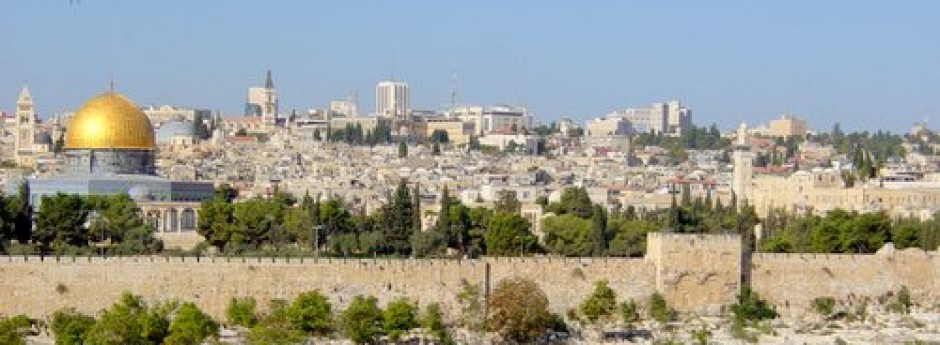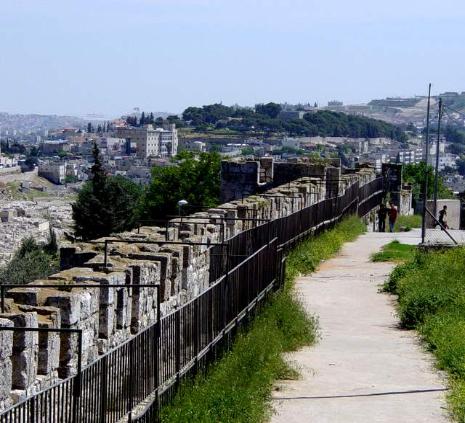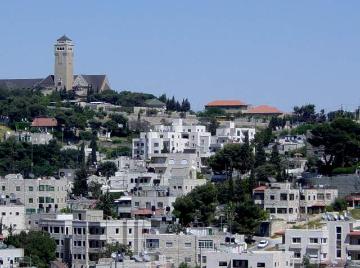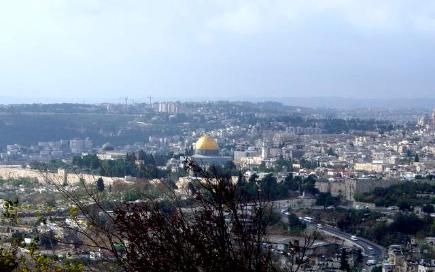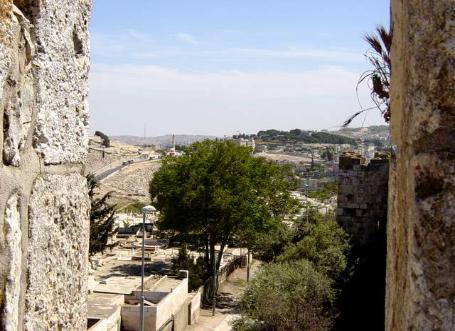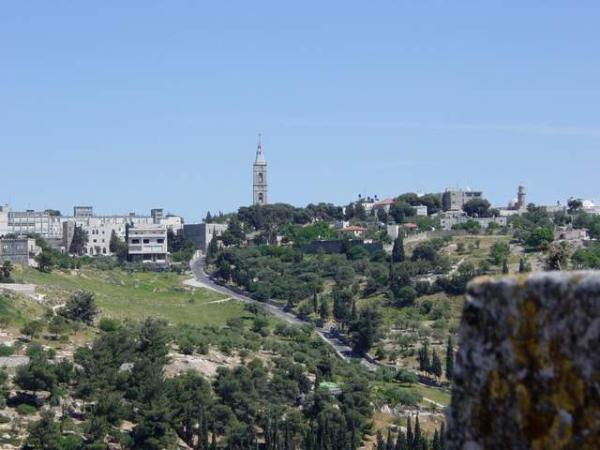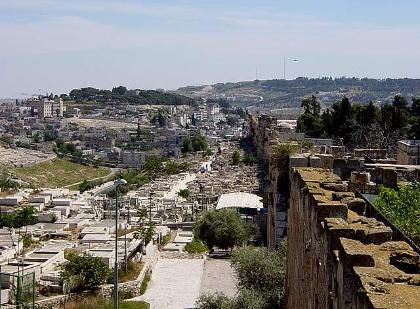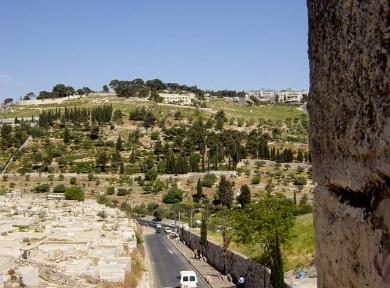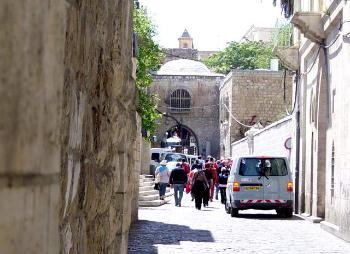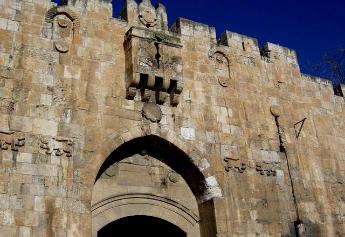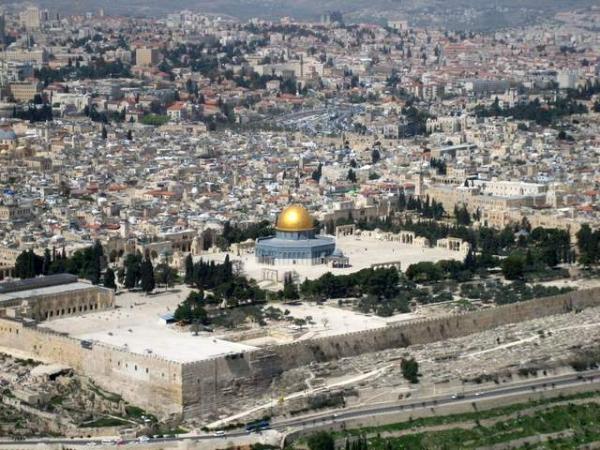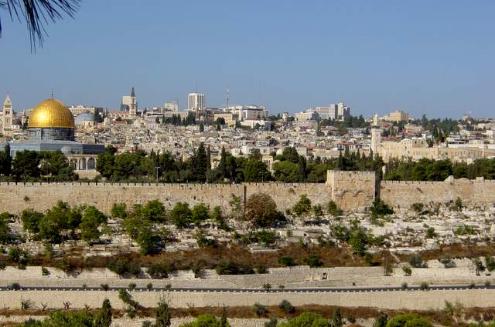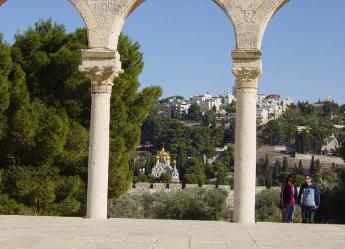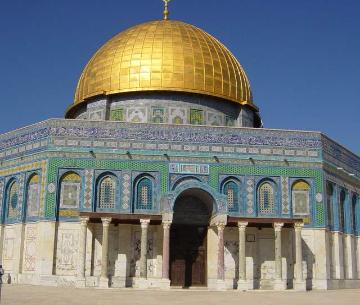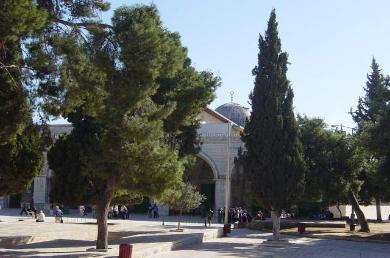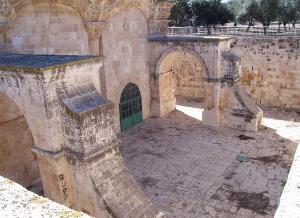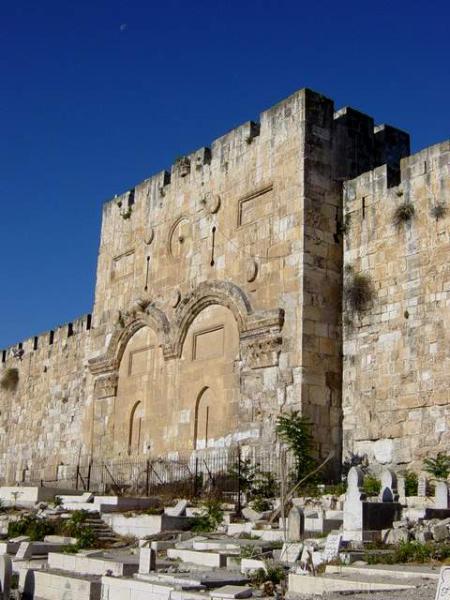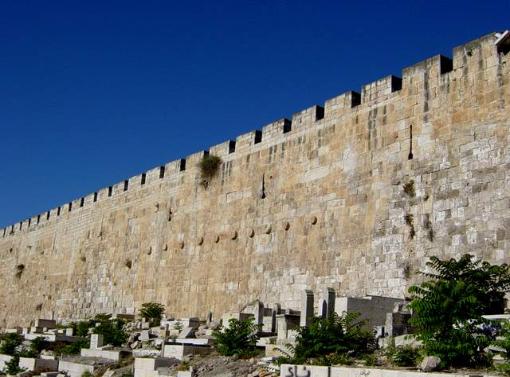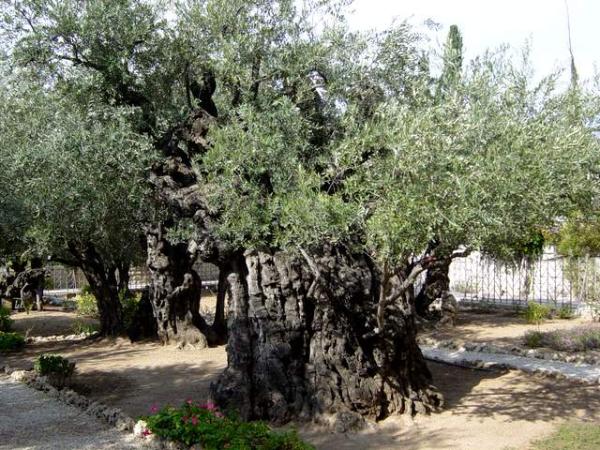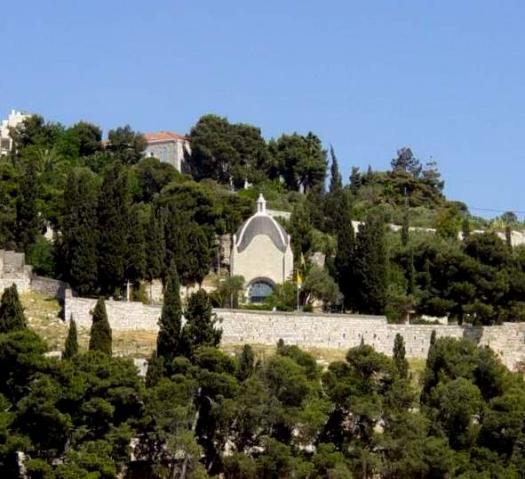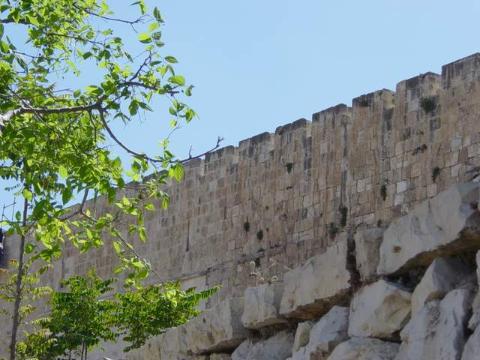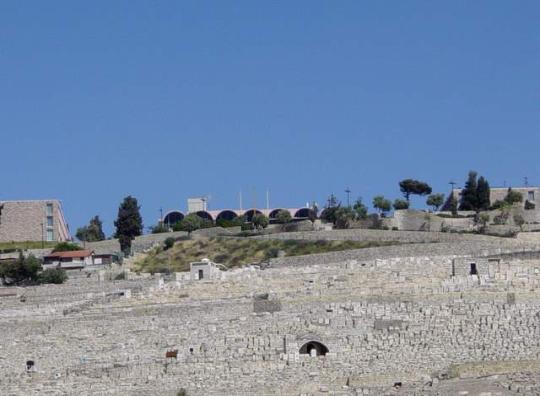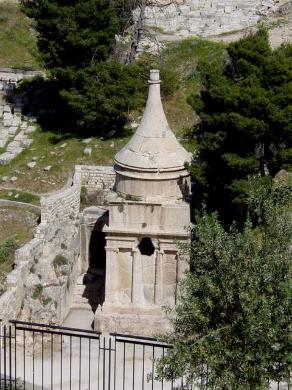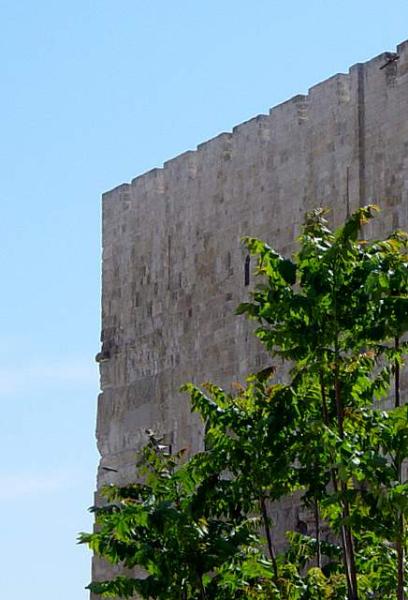THE EAST WALL
From this point we make our turn south along the eastern wall of the Old City. We see immediately before us the Hill of Offense or Mount of Scandal. Here King Solomon and his many foreign wives set up pagan altars to false gods. It was on this small hill that they incurred the wrath of the Almighty and Living God.
In our journey we are also continuing to move down the eastern side of the Muslim Quarter. Prior to the Crusades this part of the city housed many Jews. Later they were moved to their present quarter. We realize that on our left we finally have a close-up and extended view of the Mount of Olives or Olivet as it was called in the New Testament. Because of its unique chalk rocks, this mountain was more suitable than other areas of Jerusalem for the cultivation of olive trees. We will later see the traditional place where Jesus rested with his disciples. It is called Gethsemane or Gat Shemen in Hebrew, referring to the ancient olive presses found there.
The luscious valley on our left is the Kidron. It is the largest valley in the Jerusalem area and one very important to events past and future. This steep depression soon joins the Hinnom Valley and continues on through the Judean Wilderness until it reaches the Dead Sea. The deeper part of this valley just before us is known in the Bible as the Valley of Jehoshaphat or the place where God judges (Joel 3:2). The prophets of Israel picture this as one of the sites of the earth’s last great battles.
“On that day, when all the nations of the earth are gathered against her, I will make Jerusalem an immovable rock for all the nations. All who try to move it will injure themselves” (Zechariah 12:2).
We remember that it was across this valley that King David made his sorrowful retreat from Absalom (2 Sam. 15:30). In ancient times the valley was also a very fertile place where an abundance of nuts and grains were grown (2 Ki. 23:4).
As we glance to our far left we can get a close-up view of Augusta Victoria Hospital. This tower is one of the prominent landmarks on the mount. This structure was originally built by the Germans in 1898 as a hospice for pilgrims. It was later confiscated by the British after World War I. In time it became the temporary residence of the High Commissioner under the British Mandate until a permanent location was found on the Jebel Mukabir hill to the south.
In order to be completely oriented we are now going to take a look at our wall and ourselves from the Mount of Olives in the vicinity of Augusta Victoria.
As we make our way further to the south we see that the Temple Mount is coming into view with its prominent golden Dome of the Rock. In the far distance we can see the hill called Jebel Mukabir. On this hill in the 1930s the British finally established the residence of their High Commissioner as we mentioned. It is of note that the United Nations later placed its headquarters on this same hill. Over the many years this place has somehow gotten the name, “Hill of Evil Council.”
Along this hill the delightful Promenade was built in more recent times. The Promenade, which is in three large sections, provides not only a long refreshing walk with picnic areas, but an outstanding view of Jerusalem. Both the old and new cities can be seen, as well as the Mount of Olives, and the Kidron and HinnomValleys.
“As the mountains surround Jerusalem, so the LORD surrounds his people both now and forevermore” (Psalm 125:2).
Looking below us we realize that the area along the eastern city wall is almost totally occupied by a Muslim cemetery. We will stay atop the wall in order to get a better view of the Mount of Olives.
We will note that the Mount of Olives is actually taller than the Temple Mount. Its elevation is 2723 feet, or 830 meters, while the Temple Mount is only 2427 feet or 740 meters. The Mount of Olives is another of those mountains that surrounds Jerusalem spoken of in the above Psalm.
Once again the eastern ramparts are before us as well as the Muslim cemetery and another view of the Mount of Offense. To our left we can see the Old Jericho Road winding around the southern end of the Mount of Olives. Obviously we are now seeing a lot of biblically important territory both from Old Testament and New Testament times.
We now catch a good view of a second prominent landmark on top of the Mount of Olives. It is the Russian Church of the Ascension. This church was built in the 1870s by a Russian monk who is buried at the same location.
We notice E-Sheikh Street proceeding up the hill. It passes the tower and runs to the Arab village of the same name on the back side. This street also services the fairly large Arab village of E-Tur on top of the mountain. To the left of the street is the Muslim El Muqased Hospital.
Just over the crest of the Mount of Olives lie the biblical cities of Bethphage and Bethany. In Luke’s Gospel it is said: “And he led them out as far as to Bethany, and he lifted up his hands, and blessed them. And it came to pass, while he blessed them, he was parted from them, and carried up into heaven” (Luke 24:50-51). It is clear from the Old Testament prophets and from the New Testament as well that the Messiah will someday return to this very place.
“On that day his feet will stand on the Mount of Olives, east of Jerusalem” (Zechariah 14:4).
“This same Jesus, who has been taken from you into heaven, will come back in the same way you have seen him go into heaven” (Acts 1:11).
As we scan the top of the Mount of Olives once more we can see the Seven Arches Hotel. Just below is the Russian Church of Mary Magdalene with its many onion-shaped golden domes. This church was built by Czar Alexander III in 1885. It was constructed in the Russian Muscovite architectural style belonging to the 17th century. It is truly one of the most beautiful churches in Jerusalem. We will still get a closer look later in our walk. We might note that most churches built in Jerusalem and vicinity are constructed on or near ancient church buildings that have been destroyed by earthquake or war.
It becomes obvious that to walk Jerusalem’s wall is to walk through history. There is history all around us, ancient history. The wall we are walking is 400 plus years-old. By western standards this is old indeed, but by Israel’s standards it is very young. The wall in many places is built over the remains of ancient walls. Some of these go back to the First Temple period so they are approaching 3000 years in age. We might call all this “salvation infrastructure.” The Bible says of God’s work: “He has set his foundation on the holy mountain” (Psa. 87:1).
We will soon be approaching the Temple Mount and in the Bible we learn that this mount was called Moriah, pronounced Mor-ee-ah (Gen. 22:2; 2 Chr. 3:1). It was on this mount that Abraham once brought his son and heir in order to sacrifice him to God. Thus some of the stones here go back 4000 years to our Father Abraham.
What do we learn from all this? The walls we are walking on and the ancient salvation infrastructure we are seeing all declare to us that the salvation story is absolutely true. The Old Testament is true and the New Testament is true. History and archaeology are proving them true. The very stones are crying out (Lk. 19:40). Truth is springing from the ground (Psa. 85:11). Apart from the Judeo-Christian heritage, no other religion on the face of the earth has this kind of vast salvation infrastructure to display. It is also an infrastructure backed up and supported by the written word of God.
At this point we find ourselves approaching the Lions’ Gate. Once again we see that the area near the wall and continuing south is still mostly covered with a Muslim cemetery. The Lions’ Gate is also called the St. Stephen’s Gate. One tradition has it that Stephen was stoned nearby in the early first century. It was also through this gate that the Old City and Temple Mount were taken by Israeli paratroopers in the 1967 war.
From the top of Lion’s Gate we observe that a road by the same name enters the city. It is one of two gates on the eastern side and the only gate that is still open. Since we are very near the Temple Mount we cannot go much further atop the wall. So, let’s go down and take a closer look at the Lions’ Gate and the surrounding area.
Tradition has it that the famous builder of the wall, Suleiman the Magnificent, had a dream that he would be devoured by lions if he did not build a wall around the Holy City. Whether or not the tradition is true, the sultan nevertheless built the wall as well as this gate and he adorned it with two sets of lions. Actually the “lions” are panthers whose patterns were taken from the heraldic emblem of the Mamluk Sultan Baybars. Hence, we have the Lions’ Gate, and the four “lions” can still be made out, with two on each side of the entryway. We might mention that there was a much more practical reason for Suleiman to build such an enormous wall. There was a real concern in his time that the Crusaders would make another attempt to re-conquer the Middle East. Suleiman wanted to be prepared.
Since the Lions’ Gate is the only open entryway on the whole eastern side, it has become very important for Christian pilgrimages. These pilgrimages continue today to and from the Mount of Olives and to the various holy sites that are nearby within the city.
“Many peoples will come and say, ‘Come, let us go up to the mountain of the LORD, to the house of the God of Jacob. He will teach us his ways, so that we may walk in his paths.’ The law will go out from Zion, the word of the LORD from Jerusalem”
(Isaiah 2:3).
As we peek into the Lion’s Gate (#4 on our map) we can see pilgrims on their way down the street that becomes the famous Via Dolorosa. In just a short distance pilgrims usually stop at the beautiful St. Anne’s Church, which has on its grounds the Pool of Bethesda that is mentioned in the Gospels.
Pilgrims entering the Via Dolorosa
The Lions’ Gate
Before we leave the Lions’ Gate area let us back up and take a better look at the “lions” on each side of the entryway.
We now begin to walk around what is surely the most important 35 acre compound in the whole world – the Temple Mount. It is the one place on earth where the Creator of the Universe has said: “This is my resting place for ever and ever; here I will sit enthroned, for I have desired it” (Psa. 132:14).
An eagle-eye view of the sacred Temple Mount (courtesy Wikimedia Commons)
“This is what the LORD Almighty says: ‘I am very jealous for Jerusalem’” (Zechariah 1:14).
Jerusalem with its Temple Mount is the earth’s spiritual headquarters; the throne and footstool for the Mighty God. The scripture makes it very plain that God actually dwells in Jerusalem (Psa. 9:11; 135:21). In Ezekiel 43:7, God calls Jerusalem “the place of my throne and the place for the soles of my feet. This is where I will live among the Israelites forever.” It is the only city that God inscribes on the palms of his hands; it is the only city where the Mighty God watches over its walls continually (Isa. 49:16).
In Psalm 48:1-2 the scripture also says of this place: “Great is the LORD, and most worthy of praise, in the city of our God, his holy mountain. It is beautiful in its loftiness, the joy of the whole earth…Mount Zion, the city of the Great King.”
This mountain is so important that we want to get it forever imprinted in our minds. Let us take another look at it from an easterly position on the Mount of Olives. Here we see the Golden Gate or the Mercy Gate that is sealed. On our walk we will soon be approaching this gate. To the left we also see the golden Dome of the Rock. In the background is the new city of Jerusalem.
This is where the great and glorious temples of God once stood. First there was the splendid temple begun by King Solomon in 965 BC. After its destruction by the Babylonians in 586 BC, a second temple was built. This was in the days of Haggai and Zechariah (516). This temple was greatly improved and beautified by Herod the Great, shortly before the time of Jesus. After this second temple was destroyed by the Romans in AD 70 the area lay in ruins for centuries. When Christian Byzantine forces took over the control of Jerusalem after AD 325 they adorned the city with many beautiful churches. However they considered the Temple Mount as accursed. Thus they abandoned it and allowed it to become a garbage dump.
When Muslims conquered the city in 638 they expressed interest in the mount. Soon they began their first great building project there. Tradition says that Omar built a large wooden structure at this site when he conquered Jerusalem. The mosque, later known as El-Aksa, was converted into a smaller stone structure by the Umayyad Caliph El-Walid in 705. The famous Dome of the Rock was built earlier in 691 by El-Walid’s father, Abd-el-Malik. Over the centuries the El-Aksa Mosque has suffered serious earthquake damage since it is located near a large underground cavern known as Solomon’s Stables. The Dome of the Rock still remains as it was constructed since it is founded on bedrock. In fact, it is built over what is called the “foundation stone” which may have once been incorporated into the Temple. The Dome of the Rock is Islam’s third holiest site.
There is no walkway on the wall above the Temple Mount and because of religious and political tensions it is not always possible for visitors to enter the compound. However, let us take a quick cyber-tour of the mount.
A look at the Mount of Olives from near the Dome of the Rock
The Dome of the Rock
The El-Aksa Mosque
By their early construction on the Temple Mount the Muslims drove their claim deep into the heart of Judaism and Christianity. They call the Temple area in Arabic Al-Haaram e-Sherif (the noble Sanctuary), although Jerusalem, the Temple Mount and Israel are never mentioned in the Koran. However, according to their later interpretations the El-Aksa Mosque (the farthest mosque) became the very place where Muhammad landed on his famous night journey mentioned in the Koran. From the Temple area he then supposedly ascended to meet God. The Muslims point out the shape of his footprint that can still be seen inside the Dome of the Rock. Muslims also claim that it was at this sacred place that Father Abraham almost sacrificed his son. Their tradition states that the son was Ishmael rather than Isaac. Ishmael is the spiritual father of Islam.
The polemical nature of these structures can be seen by the inscriptions inside the Dome of the Rock. One cannot miss the clear rejection of the Christian doctrine of the Trinity. One inscription says: “Praise be to God, who begets no son, and has no partner.” In another place we see the words of Sura 1121: “He is God, one, eternal. He does not beget, nor is he begotten, and he has no peer.” In their eagerness to possess and control the mount the Muslims through the centuries have built some one-hundred structures there. Many of these are small, like praying platforms and porticoes.
Before we leave the Temple Mount it is imperative that we deal with the subject of sacrifice. Not only is the Temple Mount the place where the One True God wishes to dwell forever but it is also the place where humanity (through Israel) met with the True God in ages past. Clearly there was no way to approach God apart from sacrifice (Deut. 16:16). And the Bible makes plain that all sacrifice had to be offered at this spot (Deut. 12:13-14).
Sacrifice is an old, old principle in the human race going back to the dawn of history. The Bible makes clear that humankind has a sin problem because of the fall (Psa. 14:3; Isa. 64:6). In the Old Testament that problem could at least be addressed through the
sacrificial system. For this reason the Temple Mount was a massive slaughterhouse and continued to be so for many centuries. The blood of bulls, lambs and goats was continually offered up to address this problem of sin and access with a holy God.
We might say that the sacrificial system was at the heart of the Jewish religion. In Leviticus 17:11 God says: “For the life of a creature is in the blood, and I have given it to you to make atonement for yourselves on the altar; it is the blood that makes atonement for one’s life.” Prayers and good works were always required but clearly there was no approach to God without sacrifice.
When the Temple was destroyed in AD 70 it created a crisis within Judaism. For Christianity, however, there was no crisis. Christians see Jesus (Yeshua) as the Lamb of God who was prophesied to fulfill all the sacrificial system and to take away the sin of the world (Jn. 1:29). Christians see him as the Lamb slain before the foundation of the world (Psa. 40:6-8; Rev. 13:8), and that all sacrifices were but a sort of virtual reality pointing clearly to him (Heb. 10:5-7). Thus those who accept Jesus and believe in him are saved (Acts 16:31).
If we visit this area and miss the idea of sacrifice we have almost missed the Temple Mount. Millions and millions of animals were sacrificed here. Also millions and millions of liters of blood flowed down into the Kidron Valley. The Temple Mount indeed points to
humankind’s greatest and most urgent problems; the problem of access to the True God and the problem of forgiveness for our sins, past and present.
With this most serious thought in mind we will now make our exit from the Temple complex and continue with our walk around the wall. Our path will lead us through the Muslim cemetery that covers most of the eastern wall area.
Backside of the Golden Gate (courtesy Wikimedia Commons)
We quickly come upon the Mercy Gate or Golden Gate (#5 on the map). Now we want to look at it up close. In biblical times there was a gate in this area known as the Shushan Gate or Eastern Gate. This gate served the Temple Mount. The present gate was built in the seventh century by the Byzantines. Once the Muslims took control the gate was locked. In Crusader times it was opened for certain festivals but when Muslims gained control of the mount again it was closed permanently. This was done somewhere around the 13th century.
There are many traditions concerning this gate. Supposedly it was through this gate that Jesus entered on Palm Sunday (Mk. 11:8-11). Jewish people believe that the gate will be opened only when the Messiah appears. The Muslims apparently knowing of these traditions not only closed the gate but blocked it with a cemetery, feeling certain that a Jewish Messiah would not enter an area of ritual impurity brought about by the
nearby graves.
The Golden Gate
“Lift up your heads, O you gates; be lifted up, you ancient doors that the King of glory may come in.
Who is this King of glory? The LORD strong and mighty, the LORD mighty in battle.
Lift up your heads, O you gates; lift them up, you ancient doors, that the King of glory may come in.
Who is he, this King of glory? The LORD Almighty– he is the King of glory. Selah”
(Psalm 24: 7-10).
“I have posted watchmen on your walls, O Jerusalem; they will never be silent day or night. You who call on the LORD, give yourselves no rest, and give him no rest till he establishes Jerusalem and makes her the praise of the earth” (Isaiah 62:6-7).
The eastern wall of the Temple Mount forms a fairly straight line without the usual towers and indentions. Below us on the Mount of Olives we see the beautiful Basilica of the Agony or Church of All Nations as it is also called. We also see the Garden of Gethsemane adjoining it. This church was built in the early 1920s on the site of a fourth-century Byzantine structure erected by Theodosius I. The church gets its name from the fact that Christians from many nations contributed to its construction.
In the nearby Garden of Gethsemane there are located some very ancient olive trees. Probably it was in this area where Jesus rested with his disciples. It was likely here he prayed with them. No doubt it was also the place where Judas betrayed him. In this spot Jesus once cried out: “My Father, if it is possible, may this cup be taken from me. Yet not as I will, but as you will” (Matt. 26:39).
We simply cannot pass this spiritually important spot without taking a quick trip down to look into the Garden of Gethsemane where our Savior suffered. When we peek into this beautiful garden on the left side of the church we see that the olive trees are hundreds of years old. Most trees in this area were probably chopped down by the Romans as they built siege work and collected firewood in the last part of the first century. However, the olive tree possesses an amazing capacity to send out new sprouts from the old roots and continue living.
The Church of All Nations
Some ancient olive trees in the Garden of Gethsemane
As we return to our walk down the eastern wall we take a closer and parting look at the golden domes of the exquisite Mary Magdalene Church.
The Russian Church of Mary Magdalene
One beautiful and unusual structure on the Mount of Olives now comes into view. It is the Dominus Flevit Church. Traditionally it was at this site that Jesus wept over the coming destruction of Jerusalem (Lk. 19:41). Thus the church, which was constructed in 1954, was designed by its Italian architect to resemble a teardrop.
“O Jerusalem, Jerusalem, you who kill the prophets and stone those sent to you, how often I have longed to gather your children together, as a hen gathers her chicks under her wings, but you were not willing” (Matthew 23:37).
It is of note that in this area a fifth century monastery and an immense cemetery were located. In the cemetery near this church there are many ancient ossuaries and sarcophagi. Archaeologists have concluded that some of these may have belonged to Jewish-Christians.
Dominus Flevit Church
Although Jesus wept over Jerusalem from this mountain it was also from this hill that he made his triumphal entry into the city. On this occasion Jesus approached Jerusalem from the area of Bethphage. He sent some of his disciples to bring him a donkey and he rode into Jerusalem upon it. He did this to fulfill the words of Zechariah 9:9: “Rejoice greatly, O Daughter of Zion! Shout, Daughter of Jerusalem! See, your king comes to you, righteous and having salvation, gentle and riding on a donkey, on a colt, the foal of a donkey.”
As he approached the Holy City a large crowd of people began to spread cloaks and branches from the trees in his path while they exclaimed: “Hosanna to the Son of David! Blessed is he who comes in the name of the Lord! Hosanna in the highest!” (Matt. 21:9).
Unfortunately their joy soon abated and the leaders of the city began to make their dark plans to do away with Jesus. Sometime before, Jesus had spoken these woeful words concerning them and the Temple Mount that these leaders so adored: “They will not leave one stone on another, because you did not recognize the time of God’s coming to you” (Lk. 19:44).
Well, let us continue with our journey and now we will skirt along the southeast wall of the Temple Mount.
We notice that just below the Seven Arches Hotel there are thousands of Jewish graves. For Jewish people through the ages it was a final mitzvah (good deed) for one to be buried in this spot. In popular tradition it is believed that the resurrection of the dead will begin at this location.
At the foot of this very large Jewish cemetery and near the bottom of the Kidron Valley there are some interesting and very ancient tombs and monuments. The first with its unique conical roof is called The Monument of Absalom, King David’s son (cf. 2 Sam. 18:18). However, the archaeologists assure us that this monument is almost a thousand years younger than Absalom. It thus should be dated to the 1st century BC.
Tomb of the Sons of Hezir
Other interesting tombs are also located in this area. In order, they are the Tomb of the Sons of Hezir. This is the only tomb that has been positively identified by inscriptions. Apparently it belonged to the six sons of a priestly family (1 Chr. 24:15). The other tombs such as Zachariah’s Tomb (with the pyramid on top) all date to the end of the Second Temple.
In this area is also the Tomb of Jehoshaphat. Some believe this latter tomb belongs to the king of Israel with the same name. It is of interest that this whole area is referred to as the Valley of Jehoshaphat in scripture (Joel 3:2, 12). It is the place of God’s judgment of nations but it will also become a place of healing, resurrection and restoration.
“On this mountain he will destroy the shroud that enfolds all peoples, the sheet that covers all nations; he will swallow up death forever. The Sovereign LORD will wipe away the tears from all faces; he will remove the disgrace of his people from all the earth. The LORD has spoken” (Isaiah 25:7-8).
Now we are about to finish our walk around the eastern wall of Jerusalem. In fact, we can now see the very tall southeastern corner of the wall. In this corner and in many other places we notice that the older and larger stones are usually at the bottom of the wall and the stones from more recent additions are used in the upper portions.
We want to note that underneath the Temple platform in this southeastern corner there is a vast hollowed area known as Solomon’s Stables. We do not know that Solomon ever had stables here. However, we do know that when the Christian Templars controlled this site in the time of the Crusades they stabled their specially-bred war horses in this area. One estimate is that it could accommodate 2000 horses.
In recent times the Muslims have constructed what they are calling the Marwan Mosque in this underground portion. Although the whole Temple Mount is very sacred to the Jewish people this new mosque came into being through the many political maneuvers related to the Peace Process. In the past years numerous dump-truck-loads of archaeologically rich soil were emptied by the Muslims into the Kidron Valley. Many Israeli archaeologists and scholars looked on in dismay.
Today Jewish archaeologists plus numerous volunteers from Israel and other nations are slowly sifting through this ‘holy ground’ for clues to Israel’s past history and to its ancient worship on this mountain.
Obviously, the Temple Mount is the central focus of religious tensions between Judaism and Islam. In the 1967 war this area plus all the Old City fell under Israel’s control. However, because it is such a sensitive site Israel keeps only a small police presence on the mount and allows the Muslim Waqf to largely control the area. Even the nation of Jordan is still allowed to exercise some minimal jurisdiction here and the Jordanians recently were invited to come and make some emergency repairs on the southern Temple wall.
“The sons of your oppressors will come bowing before you; all who despise you will bow down at your feet and will call you the City of the LORD, Zion of the Holy One of Israel.
‘Although you have been forsaken and hated, with no one traveling through, I will make you the everlasting pride and the joy of all generations’” (Isaiah 60:14-15).
The southeastern corner of the Temple Mount
We are about ready to turn the southeastern corner and come to a main entryway into the Temple Mount. This site was the goal of millions of pilgrims who journeyed to Jerusalem over the centuries of Israel’s existence.
“I rejoiced with those who said to me, ‘Let us go to the house of the LORD’” (Psalm. 122:1).
